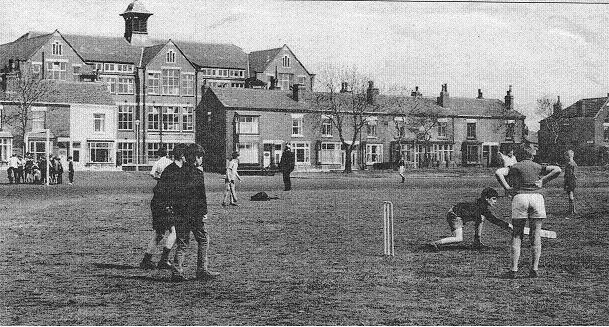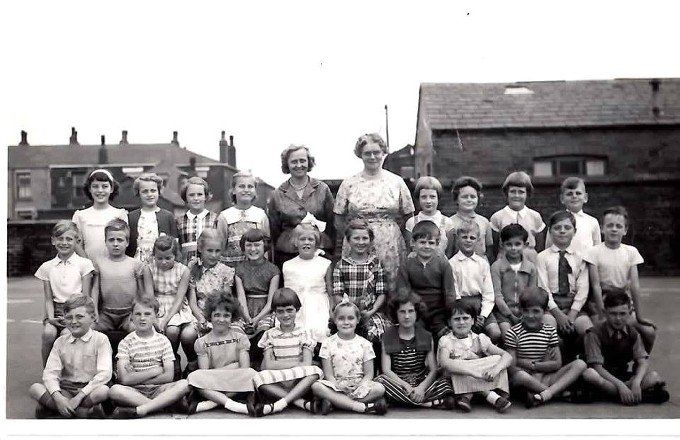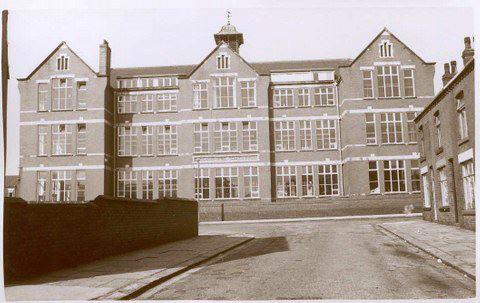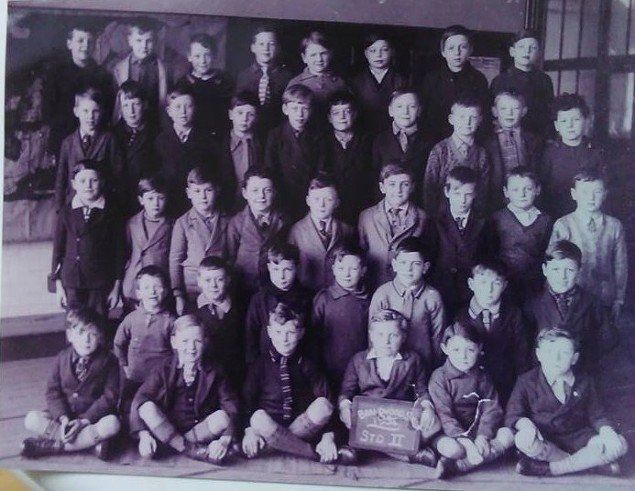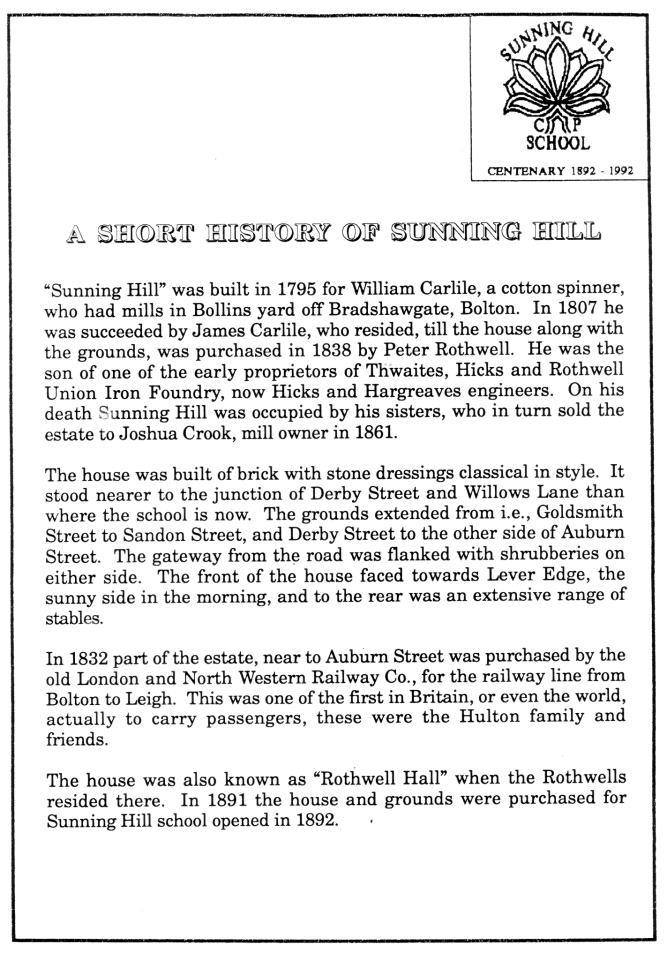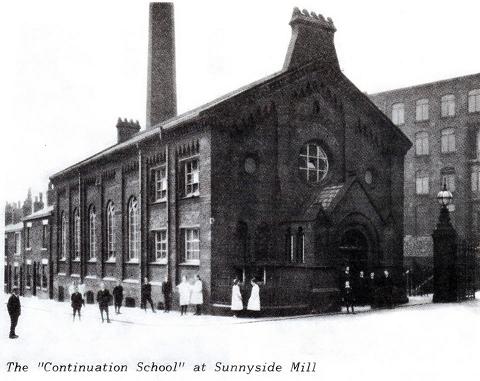Around 1858 John Tonge’s School had a building at the bottom of Barrier Street (Shed Lane). (Referred to in an article in the Bolton Journal and Guardian of Friday, 23 October 1936, reproduced in
http://www.lan-opc.org.uk/Bolton-le-Moors/Daubhill/methodist/index.html )
St Bede's A school was opened in Morris Green in 1871 and can be seen on the 1894 map though the shape of the outline does not match the building we knew in the fifties and which is little changed now. In 1880 responsibility for the school passed to the vicar of St George the Martyr’s. The older part of the present school was built before 1910 (style appears to be pre 1900) in which year it is clearly outlined on the map. By 1915 Morris Green had its own Anglican Church but the church building was not completed until October 1932.
www.st-bede.org.uk/content/view/16/33/
Sometime between these dates the name St Bedes was adopted and the school was associated with that church. This older building became “the big school” when a new building was brought into use sometime before 1929 for the nursery and Standard 1, 2, 3, and 4.
In the early 1950s Miss E Hulme was the headmistress of the infant department and Mr Clegg was headmaster of the junior department and the school as a whole. (Mrs Hulme took over as Junior Head in around 1952 at which time Miss Markland took over the infants - thanks to J D Orrell. Miss Hulme was organist at St Bede's Church for many years. Her father Stephen Hulme was one of the 66 miners from Bolton (out of total 344) killed in the Pretoria Pit disaster. Thank you Howard Hampson. Standard 1 was ruled by the very severe looking (and rather old looking to a boy of not quite five years) Mrs Latham who was quite nice really. For some reason I never knew, I joined the class some days after everyone else. I remember clearly being brought by my mother into this classroom already full of other boys and girls. My mother, seeing the crates of school milk near the door took out her purse and asked how much the milk was; she was pleasantly surprised to learn that there was no charge. I then had to copy the other children in doing what they seemed to know already what to do – in particular answering my name at register time.
No-one had informed me of the teacher’s name and thankfully my name was not first on the register. So I copied. Unfortunately, I had misheard the pupils ahead of me and for three days answered my name with, “Yes, Miss Label.” Miss Clegg (presumably the daughter of Mr Clegg) was the quite young teacher of Standard 2 whom I really liked, moving to Standard 3 as I did. The top Junior class was taught by Mrs Brown (Mrs I think, not Miss) who seemed to be known by everybody in the area.
Howard Crompton, at school more than ten years later, remembers Miss Clegg differently - "In the small school I remember Miss Clegg in the top class - a tough old bird who was pretty rough on us kids if the lesson didn’t sink in." He also reminds me of dancing round the Maypole. He recalls, "Mr. Clough the only male teacher walked us to Hulton Playing fields to play football and the school provided Green and opposite side Dark blues shirts and we had something like 15 a side on a full size pitch. When you were small it seemed huge!"
In my own day we walked to Willows Park and played football on the cinder pitch, no shirts supplied.
No such thing as swimming lessons for me but Howard Crompton remembers: "We went to Bridgeman Street baths for swimming lessons, a double decker bus hired to take us there and milk on our return , it was like an adventure but life’s pleasures in a working class environment were a lot simpler then. I don’t know why we didn't go to High Street baths."
Other teachers were Mrs Pidcott and Mrs Campbell
St Bede's School c 1961
with class teacher Mrs Pidcock and headmistress Miss E Hulme.
Photographer/owner not known.
Picture provided by Lindsay Frost and posted on Facebook by David Probett who supplied some names.
middle row - Ian Taylor,?,?,Julie Shaw,?,?,Debra Taylor,?,?,?,Ray Martin, David Probett;
front row left - Stephen Evans
Brandwood Street School sits at the highest point of the ridge of land between Daubhill and Deane, close to Willows Lane which climbs steeply up this ridge and then runs along it. The School was built some little time before 1909 and is a very fine building typical of schools built in this decade (also Church Road School, Halliwell.) Because of its elevated position it can be seen clearly from many parts of town. It seems that quite a few people who became well known or important in 20th Century Bolton started their education here including Nat Lofthouse. http://www.englandfootballonline.com/TeamPlyrsBios/PlayersL/BioLofthouseN.html
Brandwood Street School sits at the highest point of the ridge of land between Daubhill and Deane, close to Willows Lane which climbs steeply up this ridge and then runs along it. The School was built some little time before 1909 and is a very fine building typical of schools built in this decade (also Church Road School, Halliwell.) Because of its elevated position it can be seen clearly from many parts of town. It seems that quite a few people who became well known or important in 20th Century Bolton started their education here including Nat Lofthouse.
http://www.englandfootballonline.com/TeamPlyrsBios/PlayersL/BioLofthouseN.html
Sunning Hill School opened in 1892. This school is in an area which is now predominantly Asian, and although there are white people around, those with children have mostly chosen to take them elsewhere so the school population is now almost entirely non-white, mostly Pakistani Moslems but probably some Indian Hindus and a very few of other ethnic origin. The name “Sunning Hill” appears on the 1849 map and a terrace of houses and shops just slightly higher up Derby Street still displays a plaque “Sunning Hill Villa”. The site nearby which the school later occupied contains a large house and gardens, Rothwell House. It was built in 1795 for William Carlile, a cotton spinner, who had mills in Bollins yard off Bradshawgate, Bolton. In 1807 he was succeeded by James Carlile, who resided, till the house along with the grounds, was purchased in 1838 by Peter Rothwell. He was the son of one of the early proprietors of Thwaites, Hicks and Rothwell Union Iron Foundry, later Hicks and Hargreaves engineers, part of a consortium which built a locomotive (“Union”) for the Bolton and Leigh Railway. Rothwell is also commemorated by Rothwell Street further down Derby Street.
The school is not actually shown on the 1894 map. There is a school marked on Adelaide St. Is this the fore-runner of Sunning Hill?
Leaflet produced for the 1992 Centenary >>>>>>>>>>>>
St George the Martyr’s Church had a primary school from before 1879 on the site of the original iron church which moved to the corner of St Helens Road and Church Avenue. It closed in 1962 (after which the site was occupied by the Co-op, than Hanbury’s, then the Co-op again, then Costcutter and now Nisa Local).
Heathfield School was opened in 1972 to cope with the increase in population which came with the new housing from around 1965 onwards. Mr Jim Ainscough was the very capable first headmaster ably assisted by his deputy, the “stand no nonsense” but very well liked Mrs Margaret Withnell. Mrs Susan Sharples is well remembered for her musical abilities. Mr and Mrs Giles were the last of the original teachers to leave.
For some time around 1900 Sunnyside Mills had its own “continuation school”. It was on the mill site with its frontage on Adelaide Street immediately down from the railway sidings. Children left school at twelve and went intert’ mill. The school syllabus is not known, but must have continued the reading, writing and arithmetic the children had not gained sufficient proficiency in at Junior School. One would assume however that its timetable included all that these young workers would need to know about workin’ i’ t’ mill.
Islamic Schools For some years the Bolton Moslem Girls’ (Secondary) School has been running on Swan Lane and is now highly regarded. The school was ranked the third best state school in Bolton with 69 per cent of its students achieving five or more A* to C GCSEs including English and maths last summer (August 2012 results) and in 2013, 2015 and 2017 was marked by OFSTED as “outstanding”. (Do not confuse with Bolton Islamic Girls’ School on Weston Street.)
From September 2013 this was joined by a Primary School on Adelaide Street. The Olive Tree Primary School is Bolton’s first “free school” and has been set up in response to local parents and the local community under its principal, Farhat Choudry. It is a co-educational Muslim faith school for children aged four to eleven and will follow the national curriculum with a strong emphasis on literacy and numeracy making use of modern technology. Starting with 60 children in Reception and 30 in Year 1 it expects to grow to 420 pupils. (Bolton News, abridged) (It had 410 pupils in October 2018)
In 2019 a report by the Education and Skills Funding Agency found a number of failures in financial governance. A Notice to Improve was later lifted. There is no suggestion that this had deleterious effects on the pupils' welfare or education.
The next page looks at Places of Worship from around 1850

